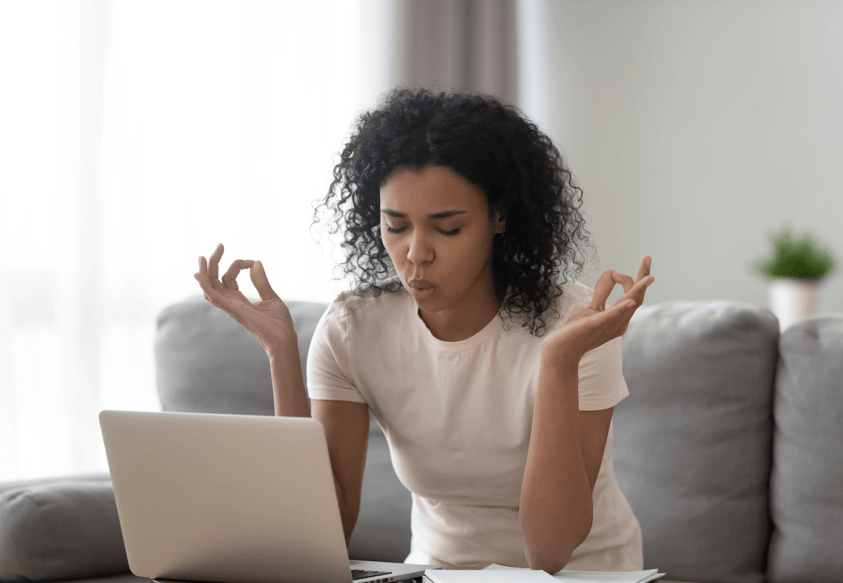As more and more information comes out about COVID-19 and COVID long haul, you might be on the hunt for COVID breathing exercises to manage your symptoms.
Our breath is powerful. It’s our life force that provides oxygen and energy to our bodies. Many of those facing the COVID-19 virus and COVID long haul have been largely impacted in their breathing quality.
Using COVID breathing exercises to promote healing can be empowering and effective; it shouldn't be overlooked.
4 COVID Breathing Exercises to Try
1. Evaluate Your Current Breathing Patterns
Start to recognize your patterns by asking yourself some questions.
- Do you usually breathe through your nose?
- When you inhale, is it more of an open-mouth sigh?
- Do you feel your breath in your chest? Or is it in your ribs? Maybe you feel it in your abdomen?
- Does your chest feel tight when you try to inhale deeply?
- Are you able to fill your lungs with air?
2. Become Aware of Your Breath
Take note if there is any discomfort when you take a breath. Are any noticeable pains? If you do notice something uncomfortable, we recommend consulting with your doctor.
Keep in mind, as you become increasingly aware of your breath, it may feel uncomfortable at first. This discomfort is common, as you are intentionally activating specific muscles that may not have been used in a while.
3. Use your Breath Through Relapses
Use your breath to guide you through relapses. Post-COVID symptom exacerbation often happens throughout the day from various triggers. Whenever you feel the tingling, wheezing, brain fog, joint pain, chest congestion, etc., try using one of the exercises below and observe how they affect your symptoms.
4. Designate Breath Breaks
Start to implement designated breathing breaks throughout the day. Just as we need to set aside time every day to eat, hydrate, and sleep, these practices are a fundamental part of life.
As with any habit, initially, it takes time and intention to see these to completion. However, after some time, it’s part of your daily routine. We feel the same way about breathing. Scheduling regular breaks throughout the day to pause, take a moment to acknowledge the present moment, and activate our breath can help shift our body into the parasympathetic nervous system.
The most important aspect is that as the body switches into this resting state, this is where the healing takes place. For a guided experience, join a live daily breath break with @mymeehealth on Instagram. Also, live on Sundays, Monisha Raja, founder of Yoga for COVID™, hosts a yoga practice session on our Instagram channel, too. These types of guided exercises are a great way to help you start managing your breath regularly.

Ways to Improve Your Breathing
Breathing seems like a natural thing, yet there are many ways to improve your breathing to obtain many physiological benefits. You may have heard of the “fight or flight” response or sympathetic/stress response. Learning to breathe more efficiently helps your body to counteract the sympathetic response and elicit the parasympathetic response, or a state of relaxation that allows your body to focus on healing.
Practice these exercises a few times a day to train your body to breathe more effectively. You may find these exercises easier to do with eyes closed, but they can be completed with eyes opened as well.
- DIAPHRAGMATIC BREATHING: Sit in a chair with good posture and place a hand on your belly. Breathe in slowly, and notice your belly filling up with air like a balloon. Exhale using pursed lips, and repeat.
- 2 - 1 BREATHING: This means when you inhale, you make a point to exhale for twice as long. For example, breathing in a count of 3 would equal exhaling for a count of 6.
- 4 - 7 - 8 BREATHING: Find a place to sit or lay comfortably. Breathe in through your nose for a count of 4. Hold your breath for a count of 7. Exhale through your mouth for a count of 8. Inhale again and repeat the cycle 3 more times for a total of 4 breaths. This exercise is especially beneficial when having trouble falling asleep.
- PURSED BREATHING: Breathe in through your nose, and then using pursed lips breathe out through your mouth for twice as long as you breathed in. A good visual for this exercise is to breathe in like you’re smelling a flower and breathe out like you’re blowing out a candle.
- HUMMING BEE BREATHING: Find a comfortable place to sit with good posture. Practice pursed breathing for a couple of breaths to get your mind focused. Place your thumb and pointer finger on the tragus cartilage of your ear. Inhale. Exhale while simultaneously pressing on the cartilage and making a soft humming sound. Repeat for as long as you’d like.
- ALTERNATE NOSTRIL BREATHING: This breathing practice has been shown to improve cardiovascular function. Sitting with good posture, start with a few breaths of diaphragmatic breathing. Then, lightly close your right nostril with your thumb. Inhale and exhale for an equal count, and then switch sides. This completes one round. Complete a total of 6 rounds, and then release your thumb from your nose and breathe three deep breaths using both nostrils with the diaphragmatic breathing technique.
The Mymee COVID long haul core program is a great way to identify your triggers and manage your symptoms long-term. Schedule a call to learn more about the benefits of having a dedicated health coach and how Mymee coaches can help you feel like yourself again.


